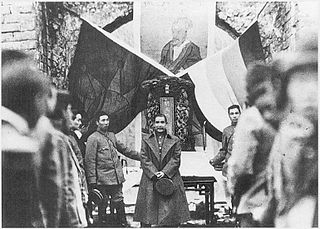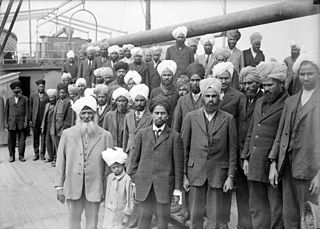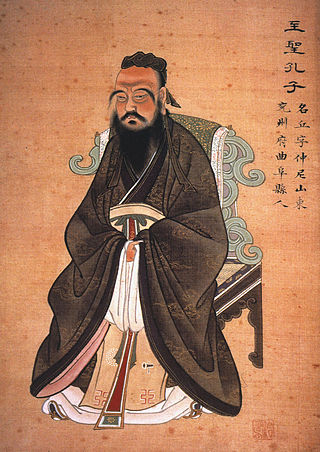
An ethnic stereotype, racial stereotype or cultural stereotype involves part of a system of beliefs about typical characteristics of members of a given ethnic group, their status, societal and cultural norms. A national stereotype, or national character, does the same for a given nationality. The stereotyping may be used for humor in jokes, and/or may be associated with racism.

Han nationalism is a form of ethnic nationalism asserting ethnically Han people as the exclusive constituents of the Chinese nation. It is often in dialogue with other conceptions of Chinese nationalism, often mutually-exclusive or otherwise contradictory ones. Han people are the dominant ethnic group in both states claiming to represent the Chinese nation: the Republic of China and the People's Republic of China. Han people also constitute a sizable ethnic minority or plurality group in a number of other countries, such as Malaysia and Singapore. In the modern era, ethnicity's role in the Chinese nation continue to color conceptions of Chinese culture, geopolitics, and history.
Iranians or Iranian people may refer to:

Koreans are an East Asian ethnic group native to Korea. The majority of Koreans live in the two states of North and South Korea, which are collectively referred to as Korea. As of 2021, an estimated 7.3 million ethnic Koreans resided outside of Korea. Koreans are also an officially recognized ethnic minority in other Asian countries, including China, Japan, Kazakhstan, Russia, and Uzbekistan. Outside of Asia, sizeable Korean communities have formed in Germany, the United Kingdom, France, the United States, Canada, and Oceania.
The phrase fresh off the boat(FOB), off the boat(OTB), are sometimes-derogatory terms used to describe immigrants who have arrived from a foreign nation and have yet to assimilate into the host nation's culture, language, and behavior, but still continue with their ethnic ideas and practices. Within ethnic Asian circles in the United States, the phrase is considered politically incorrect and derogatory. It can also be used to describe the stereotypical behavior of new immigrants as, for example, their poor driving skills, that they are educated yet working low-skilled or unskilled jobs, and their use of broken English. The term originates in the early days of immigration, when people mostly migrated to other countries by ship. "Fresh off the Boeing 707" is sometimes used in the United States as a variation, especially amongst East, South and Southeast Asian immigrants. In the United Kingdom "fresh off the boat" are referred to as freshies or simply FOBs.
A model minority is a minority demographic whose members are perceived as achieving a higher degree of socioeconomic success than the population average, thus serving as a reference group to outgroups. This success is typically measured relatively by educational attainment; representation in managerial and professional occupations; and household income, along with other socioeconomic indicators such as low criminality and high family/marital stability. The concept of model minority is associated with Asian Americans in the U.S. Many European countries have concepts of classism that stereotype ethnic groups in a similar manner.
The anti-bias curriculum is an activist approach to educational curricula which attempts to challenge prejudices such as racism, sexism, ableism, ageism, weightism, homophobia, classism, colorism, heightism, handism, religious discrimination and other forms of kyriarchy. The approach is favoured by civil rights organisations such as the Anti-Defamation League.

British Asians are British citizens of Asian descent. They constitute a significant and growing minority of the people living in the United Kingdom, with 6.9% of the population identifying as Asian/Asian British in the 2011 United Kingdom census. This represented a national demographic increase from a 4.4% share of UK population in 2001.
Asian Australians refers to Australians of Asian ancestry, including naturalised Australians who are immigrants from various regions in Asia and descendants of such immigrants. At the 2021 census, the proportion of the population identifying as Asian amounted to approximately 17.4 percent with breakdowns of 6.5 percent from Southern and Central Asia, 6.4 percent from North-East Asia, and 4.5 percent from South-East Asia.

Stereotypes of East Asians in the United States are ethnic stereotypes found in American society about first-generation immigrants, and American-born citizens whose family members immigrated to the United States, from East Asian, and as well as members of the Chinese diaspora who hail from Southeast Asian countries such as Brunei, Cambodia, East Timor, Indonesia, Laos, Malaysia, Myanmar, Philippines, Singapore, Thailand, and Vietnam. Stereotypes of East Asians, like other ethnic and racial stereotypes, are often erroneously and negatively portrayed in American mainstream media, in cinema, in music, on television, in literature, on the internet, as well as in other forms of creative expression in American culture and society. Many of these commonly generalized stereotypes are largely correlative to those that are also found in other Anglosphere countries, such as in Australia, Canada, New Zealand, and the United Kingdom, as mass media are often closely interlinked between these countries.

Stereotypes of South Asians are broadly believed impressions about individuals of South Asian origin that are often inconsistent with reality. While the impressions are wrongly presumed to be universally true for all people of South Asian origin, these stereotypes adversely affect the South Asians as well as the acculturation process.
Dragon Lady is usually a stereotype of certain East Asian and occasionally South Asian and/or Southeast Asian women as strong, deceitful, domineering, mysterious, and often sexually alluring. Inspired by the characters played by actress Anna May Wong, the term comes from the female villain in the comic strip Terry and the Pirates. It has since been applied to powerful women from certain regions of Asia, as well as a number of Asian and Asian American film actresses. The stereotype has generated a large quantity of sociological literature. "Dragon Lady" is sometimes applied to persons who lived before the term became part of American slang in the 1930s. "Dragon Lady" is one of two main stereotypes used to describe women, the other being "Lotus Blossoms". Lotus Blossoms tend to be the opposite of the Dragon Lady stereotype, having their character being hyper-sexualized and submissive. Dragon Lady is also used to refer to any powerful but prickly woman, usually in a derogatory fashion.
An Asian fetish is a strong sexual preference for people of Asian descent or heritage. The term generally refers to people of East or Southeast Asian descent, though this may also include those of South Asian descent.
There are stereotypes of various groups of people which live within the United States and contribute to its culture. Worldwide, a disproportionately high number of people know about these stereotypes, due to the transmission of American culture and values via the exportation of American-made films and television shows.
Second-generation immigrants in the United States are individuals born and raised in the United States who have at least one foreign born parent. Although the term is an oxymoron which is often used ambiguously, this definition is cited by major research centers including the United States Census Bureau and the Pew Research Center.

Concepts of race and sexuality have interacted in various ways in different historical contexts. While partially based on physical similarities within groups, race is understood by scientists to be a social construct rather than a biological reality. Human sexuality involves biological, erotic, physical, emotional, social, or spiritual feelings and behaviors.
Han Chinese chauvinism is a political ideology that speaks out for the ethnic Han Chinese people and its uniqueness throughout human history. It differs from Chinese chauvinism, because it is only used in reference to people who are of Han Chinese ethnicity, the main ethnicity of China. Han chauvinists believe that the current influence from the West has downgraded the development of China's own cultural customs, and in response, it has become instrumental in leading the increasingly traditionalist movement, which was launched in 2001. Participants come together both online and in person in cities across China to revitalize their vision of the authentic “Great Han” and corresponding “real China” through traditional ethnic dress and Confucian ritual.

Eastern culture, also known as Eastern civilization and historically as Oriental culture, is an umbrella term for various cultural heritages of social norms, ethical values, traditional customs, belief systems, political systems, artifacts and technologies of the Eastern world.







